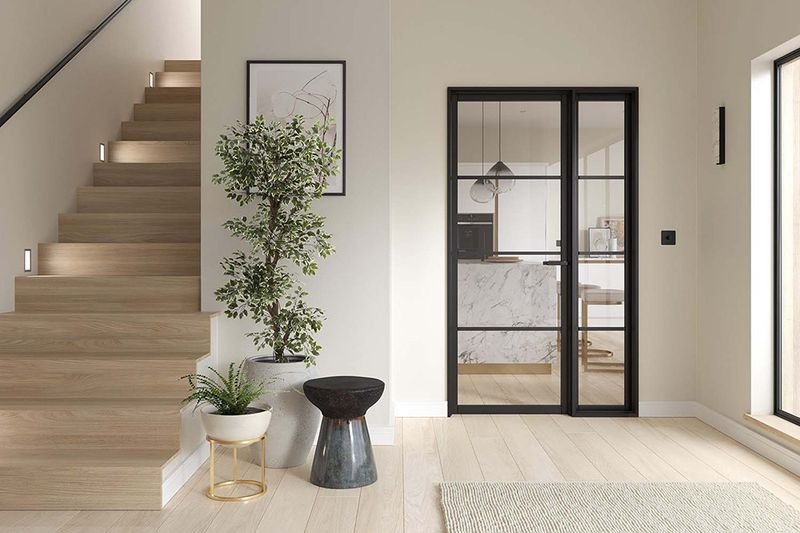Door frames are an essential yet often overlooked component of any home. They provide structural support, ensure proper door function, and contribute to the overall aesthetics of a space. This article will explore the different aspects of door frames, from their types and materials to installation and maintenance, providing valuable information and solutions for homeowners.
Why Are Door Frames Essential Components of Your Home?
Door frames are the structures that surround and support a door, allowing it to open and close properly. They consist of several parts, including the head, jambs, and sill. The head is the top horizontal piece, the jambs are the vertical sides, and the sill is the bottom horizontal piece.
Together, these parts guarantee that the door stays firmly in position and operates effortlessly
Door frames are crucial for several reasons:
- Structural Support: They provide stability and strength to the door, preventing it from sagging or warping.
- Security: A well-installed door frame enhances security by making it harder for intruders to break in.
- Energy Efficiency: Properly fitted door frames help seal gaps, reducing drafts and improving energy efficiency.
- Aesthetics: They contribute to the overall look of a room, complementing the door and the surrounding decor.
What Are the Different Types of Door Frames?
There are various kinds of door frames, each designed for specific purposes and styles. Knowing these types can assist homeowners in selecting the most suitable option for their requirements.
- Wooden Door Frames: These are the most common and versatile type of door frames. They can be crafted from various kinds of wood, such as oak, pine, or mahogany, offering a range of finishes and styles. Wooden frames are durable, aesthetically pleasing, and can be customized to fit any design.
- Metal Door Frames: Typically made from steel or aluminum, metal door frames are known for their strength and durability. They are often used in commercial buildings but are also suitable for residential use, especially in areas requiring enhanced security or fire resistance.
- UPVC Door Frames: Unplasticized polyvinyl chloride (UPVC) frames are popular for their low maintenance and weather-resistant properties. They are commonly used in exterior doors, such as patio or front doors, providing good insulation and security.
- Composite Door Frames: Made from a combination of materials like wood, metal, and plastic, composite door frames offer the benefits of each material. They are strong, durable, and resistant to weather and insects, making them an excellent choice for exterior doors.
- Pre-Hung Door Frames: These frames come with the door already attached, making installation easier and faster. Pre-hung frames are ideal for new constructions or major renovations, ensuring the door and frame fit perfectly together.
Read Also: What Time Is It in Maui? Tips for Managing Time Zones
How to Choose the Right Door Frame Material?
Selecting the right material for a door frame depends on various factors, including the location, budget, and desired aesthetics. Here are some considerations for homeowners:
- Location: For exterior doors, materials that offer weather resistance and security, such as metal or UPVC, are ideal. For interior doors, wooden frames provide a warm and classic look.
- Budget: Wooden frames can vary significantly in price depending on the type of wood used. Metal frames are generally more affordable and durable, while UPVC and composite frames offer a balance between cost and performance.
- Maintenance: Wooden frames may require regular maintenance, such as painting or varnishing, to keep them looking good and prevent damage. Metal and UPVC frames are low maintenance, needing only occasional cleaning.
- Aesthetics: The choice of material should complement the overall design of the home. Wooden frames give a classic and sophisticated look, whereas metal and UPVC frames deliver a contemporary and streamlined aesthetic..
What Are the Steps to Install a Door Frame?
Installing a door frame can be a challenging task, but with the right tools and instructions, it can be done successfully. Here is a step-by-step guide:
- Measure the Opening: Accurate measurements are crucial for ensuring the door frame fits properly. Measure the width, height, and depth of the opening where the frame will be installed.
- Prepare the Opening: Remove any old frames and clean the area thoroughly. Ensure the opening is level and free of debris.
- Assemble the Frame: If the frame comes in pieces, assemble it according to the manufacturer’s instructions. Make sure all joints are secure and the frame is square.
- Position the Frame: Place the assembled frame in the opening, ensuring it is level and plumb. Use shims to adjust the frame and hold it in place.
- Secure the Frame: Nail or screw the frame into the wall studs, starting with the top and then securing the sides. Check that the frame remains level and plumb throughout the process.
- Install the Door: Hang the door on the hinges and check for proper alignment.Make any required adjustments to guarantee the door operates smoothly when opening and closing..
- Finish the Installation: Fill any gaps between the frame and the wall with insulation or caulk to improve energy efficiency. Install the trim and paint or finish the frame as desired.
How to Maintain and Repair Door Frames?
Proper maintenance and timely repairs can extend the life of door frames and keep them looking good. Here are some tips for homeowners:
- Regular Cleaning: Clean door frames regularly with mild soap and water to remove dirt and grime. Steer clear of strong chemicals that might harm the finish.
- Inspect for Damage: Check door frames periodically for signs of damage, such as cracks, warping, or rot. Quickly resolve any problems to stop them from worsening..
- Repaint or Refinish: Wooden frames may need to be repainted or refinished every few years to protect them from moisture and wear. Sand the surface lightly before applying a new coat of paint or varnish.
- Lubricate Hinges: Apply lubricant to door hinges to ensure smooth operation and prevent squeaking. This also helps reduce wear on the hinges and frame.
- Repairing Minor Damage: Small cracks or dents can be filled with wood filler or putty and then sanded smooth. For more significant damage, it may be necessary to replace a section of the frame or the entire frame.
What Are Typical Door Frame Issues and How Can They Be Resolved?
Door frames can encounter various issues over time, but many of these problems can be resolved with simple fixes.Below are a few typical issues and how to address them::
- Sticking Doors: This is often caused by humidity or settling of the house, which can make the door frame swell or warp. Smoothing the door edges with sandpaper or adjusting the hinges can resolve this problem..
- Gaps Around the Door: Gaps can lead to drafts and reduced energy efficiency. Adding weatherstripping or adjusting the frame can help seal these gaps.
- Loose Frames: Over time, door frames can become loose, making the door difficult to open or close. Tightening the screws or adding shims can secure the frame in place.
- Rotting Wood: Wooden frames are susceptible to rot, especially if exposed to moisture. Replacing the affected section with new wood and treating it with a preservative can prevent further damage.
- Cracked or Broken Frames: Significant cracks or breaks in the frame may require replacing the entire frame. This is a more extensive repair but is necessary to maintain the structural integrity of the door.
How Can You Select the Best Door Frame for Your Home?
Choosing the right door frame involves considering several factors, including the type of door, the style of the home, and personal preferences.Consider these guidelines to assist homeowners in making the best selection:
- Match the Door: Ensure the frame complements the door in terms of style and material. For instance, a solid wood door looks best with a wooden frame, while a sleek metal door pairs well with a metal frame.
- Take the Home’s Style into Account: The frame should complement the home’s architectural design. A modern home may benefit from clean, minimalist frames, while a traditional home might look better with ornate wooden frames.
- Think About Functionality: Consider how the door will be used. For high-traffic areas, durable materials like metal or composite are ideal. For less frequently used doors, wooden frames can add a touch of elegance.
- Budget Wisely: While it’s essential to invest in a quality frame, it’s also important to stay within budget. Compare different materials and styles to find the best balance between cost and quality.
- Seek Professional Advice: If unsure, consult with a professional contractor or designer. They can provide valuable insights and recommendations based on the specific needs and style of the home.
Conclusion
Door frames are a vital part of any home, providing structural support, security, and aesthetic appeal. Understanding the different types, materials, and installation processes can help homeowners make informed decisions and maintain their door frames effectively. Regular maintenance and timely repairs can extend the life of door frames, ensuring they continue to function properly and look good for years to come. By considering the factors discussed in this article, homeowners can choose the right door frame that meets their needs and enhances the overall appeal of their home.













